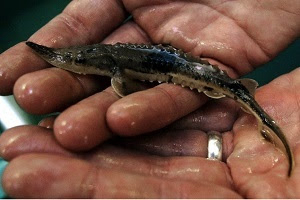
|
Every few years, the U.S. Fish and Wildlife Service treats rivers across Michigan with a chemical aimed at killing the invasive sea lamprey. Two of those rivers – the Big Manistee and the Muskegon – are home to lake sturgeon as well as sea lamprey. While many aquatic species aren’t affected by the treatments, lake sturgeon, especially in these locations, are. In fact, the water chemistry there means lake sturgeon exposed to the chemical have a higher chance of dying.
This month and next, the Little River Band of Ottawa Indians is heading up an effort to protect juvenile lake sturgeon from these sea lamprey treatments. The DNR, the Fish and Wildlife Service and Gun Lake Tribe are on board, too.
“Lake sturgeon are an important species in the Great Lakes ecosystem, and it’s critical to protect and restore these populations because of their historical and cultural significance,” said Emily Martin, a fisheries biologist with the DNR’s Tribal Coordination Unit. “Collaboration like this makes us more effective in protecting a species that’s important to a variety of people and many agencies.”
Crews from participating agencies are capturing juvenile lake sturgeon at night, targeting them from boats while scanning the Big Manistee and Muskegon river bottoms with spotlights. Fish are collected with dip nets and transported to the Little River Band’s sturgeon-rearing facility located on the banks of the Manistee River and Grand Valley State University’s Annis Water Resources Institute on Muskegon Lake.
During the last sea lamprey treatment on the Big Manistee River in 2016, 117 lake sturgeon were collected and placed in the rearing facility. Following the completed chemical treatment, the fish were safely released back at the point of capture. Meanwhile, before the 2017 treatment on the Muskegon, crews collected and later released 28 lake sturgeon.
"This collaborative effort is a great way to supplement the restoration efforts of lake sturgeon populations on the Manistee and Muskegon rivers,” said Corey Jerome, a fisheries biologist with the Little River Band of Ottawa Indians. “The collection efforts help protect an age class of sturgeon that experiences high natural mortality early on in their life stages."
Questions? Contact Emily Martin, 231-547-2914, ext. 241 or Corey Jerome, cjerome@lrboi-nsn.gov.